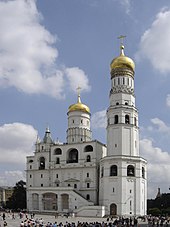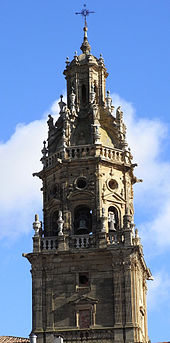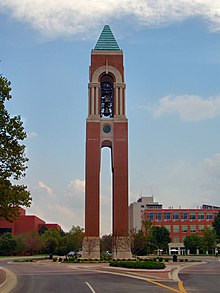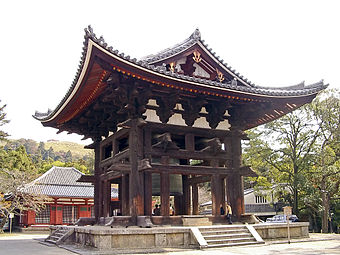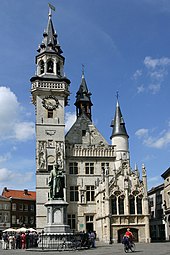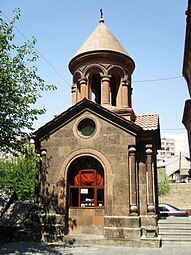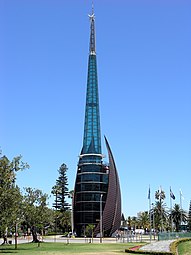종탑
Bell tower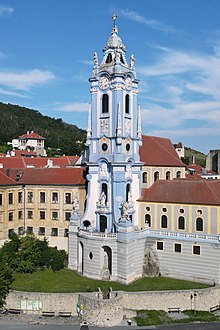
종탑은 하나 이상의 종을 포함하거나 종이 없어도 종을 고정하도록 설계된 탑이다.이러한 탑은 일반적으로 기독교 교회의 일부로서 기능하며 교회 종소리를 포함할 것이지만, 종종 도시 건물, 교육 시설 또는 카리용을 수용하기 위해 특별히 지어진 탑인 많은 세속적인 종탑도 있습니다.교회 종탑은 종종 시계를 포함하며, 세속적인 종탑은 보통 공공 서비스로 사용됩니다.
캄파닐레(/kkanmp italiannilili, -leɪ/, 미국명: /ɑk-m-/, 이탈리아어: [kampaːni]le])는 이탈리아어 캄파닐레에서 유래한 말로, 종탑과 동의어이다. 영어 사용법에서 캄파닐레는 자유로운 종탑을 가리키는 경향이 있다.종탑은 일부 전통에서 종탑이라고 불리기도 하지만, 이 용어는 종탑 전체가 아닌 종과 종탑을 수용하는 하부 구조물을 의미하기도 한다.
세계에서 가장 높은 독립 종탑은 113.2미터(371피트) 높이로 이탈리아 [1][2]프리울리 베네치아 줄리아 지역에 있는 모테글리아노 종탑이다.
목적
멀리서도 들을 수 있도록 탑에서 종을 울린다.교회 종은 예배자들이 공동 예배를 위해 교회에 가는 시간을 나타낼 수 있고, 교회 예배 시간에 숫자 7이 포함되어 있는 정례적인 시간이라고 불리는 매일 기독교 기도의 고정된 시간을 나타낼 수 있습니다.그들은 또한 결혼식이나 장례식 같은 특별한 행사에서도 울린다.일부 종교적 전통에서는 예배의 특정 부분에 [3]도달했음을 사람들에게 알리기 위해 예배의 예배 내에서 사용됩니다.
종탑은 하나의 종 또는 공통 음계에 맞춰 조정된 종 집합을 가질 수 있습니다.그것들은 정지해 있고 울리고, 작은 호를 통해 무작위로 울리거나, 영어 변화 울림의 고도의 제어를 가능하게 하기 위해 완전한 원을 통해 울릴 수 있다.그들은 키보드와 케이블을 통해 연결된 망치로 종을 울리는 카리용이나 차임벨을 수용할 수 있다.이것들은 대학 [4]캠퍼스를 포함한 유럽과 미국의 많은 교회와 세속적인 건물에서 볼 수 있다.
종소리를 흉내내기 위해 다양한 전자 장치가 존재하지만, 상당한 금액이 투자된 실질적인 탑에는 일반적으로 실제 종들이 있을 것이다.
어떤 교회들은 종탑 안에 폭풍이나 과도한 비와 같은 날씨와 관련된 재난을 막기 위한 의식을 치르던 공간인 종탑 안에 퇴관실이 있다.무르시아 대성당의 주요 종탑에는 4개가 있다.
기독교에 많은 교회 belltowers 하루에 세번에서 9시까지인지라, 12시부터 오후 3시 주 기도문 암송하는 데 기독교 신자들을 소환할;[5][6][7] 그 가처분 명령은 주님의 기도 세번 신문 Didache 8,2에 기도하기에 그들의 교회 종이 울리f.,[8][9][10]을 차례로 세번 기도하는 유대인 연습하여 영향을 받았다.매일 그에서 발견되구약성서, 특히 "저녁과 아침과 정오"를 암시하는 시편 55장 17절과 예언자 다니엘이 [8][9][11][12]하루에 세 번 기도하는 다니엘 6장 10절에 나옵니다.초기 기독교인들은 아침 9시, 낮 12시, 오후 [13]3시에 기도하러 왔습니다.이렇게 기독교에서는 많은 루터 교회와 성공회 교회들이 하루에 세 번 종탑에서 교회 종을 울립니다: 아침, 정오, 저녁에 기독교인들을 불러 주의 기도를 [5][6][14]낭송합니다.많은 가톨릭 교회들은 매일 오전 6시, 정오, 오후 6시에 신도들을 불러 신의 [15][16]화신을 기리는 기도인 '안젤루스'를 낭송한다.콥트교나 인디언과 같은 동양정교회 교인들은 아그페야교나 셰히모교와 같은 짧은 기도문을 사용하여 동쪽을 향해 하루에 일곱 번 기도한다; 교회 종은, 특히 수도원에서, 이 일곱 개의 고정된 기도 시간을 기념하기 위해 울린다.시편 119:164)[17][18]
종탑에서 교회 종이 울리는 기독교 전통은 미나레에서 [19][20]나오는 아단의 이슬람 전통과 유사합니다.
더 이상 본래의 목적을 위해 사용되지 않는 오래된 종탑은 역사적 또는 건축적 가치를 위해 유지될 수 있지만, 강한 종탑학적 전통을 가진 나라에서는 종종 종이 계속 울린다.
역사
유럽
서기 400년, 놀라의 파울리누스는 교회 종을 기독교 [21][22]교회에 도입했다.11세기까지 종탑에 보관된 종은 흔한 것이 되었다.[22]
역사적인 종탑은 유럽 전역에 존재한다.아일랜드 원형 타워는 부분적으로 종탑의 역할을 했던 것으로 생각된다.유명한 중세 유럽의 예로는 브루주(브뤼주의 벨트), 이프레르(크로스 홀, 이프레르), 겐트(헨트의 벨트) 등이 있다.하지만 아마도 유럽에서 가장 유명한 독립 종탑은 이탈리아 피사에 있는 두오모 디 피사의 캄파닐레인 소위 "피사의 기울어진 탑"일 것이다.1999년에 32개의 벨기에 종탑이 유네스코 세계문화유산에 추가되었다.2005년에 이 목록은 벨기에 1개와 북프랑스 23개로 확대되었고, 그 이후로 벨기에와 프랑스의 벨프리로 알려져 있다.이들 중 대부분은 중세 시대에 이 지역의 도시들이 얻은 더 큰 힘의 상징으로 주로 시청에 부착되었다. 종탑이나 그 천막과 같이 종탑과 연결되지 않은 소수의 건물도 같은 목록에 나타난다.중세 시대에 도시들은 때때로 그들의 중요한 문서들을 종루 안에 보관했다.모든 것이 대규모인 것은 아니다; 슬로바키아의 카투에 있는 "종" 탑은 한때 시골 지역에서 흔했던 훨씬 더 평범한 건축물들 중의 전형이다.오래된 나무 종탑은 리투아니아와 폴란드의 일부 지역뿐만 아니라 인접한 교회에서도 살아남습니다.
동유럽 정교회에서는 종소리도 문화적 의미가 강하며(러시아 정교회 종소리), 교회는 종루로 지어졌다(높은 정교회 종루 목록 참조).
중국
종탑(중국어: Zhonglu, 일본어:쇼로)는 중국과 관련 문화권에서 흔히 볼 수 있다.그들은 종종 드럼탑과 짝을 이루는 사원 단지와 지역 교회 건물의 일부로 나타날 수 있다.가장 잘 알려진 예로는 베이징의 종루(종루)와 시안의 종루가 있다.
갤러리
- 종루, 종루, 캄파닐 등 날짜별 종루
세인트루이스 수도원의 종탑.보스니아 헤르체고비나 모스타르의 피터와 폴
일본 도대지의 옛 종루(752, 1200개 재건)
콘월 피크 처치에 있는 개별 종탑(13세기)
베이징 종탑(1272, 1420, 1800년 재건)
노던아이오와 대학교 캄파닐(1927년)
시안 종탑(1384)
벨기에 알스트의 종루 (1460)
벨기에 브루주의 종탑(1240년)(1480년대, 1820년 개조)
선한 목자 교회 종탑 (펜실베이니아 로즈몬트) (1894년)
새터 타워(더 캄파닐레로 더 일반적으로 알려져 있음), 캘리포니아 버클리(1914년)
프랑스 릴의 종탑 (1921년)
미국 플로리다 주 레이크웨일스 주 복타워 가든의 싱잉타워(1929년)
레인보우 타워, 나이아가라 폭포, 캐나다 (1947년)
KS 로렌스 캔자스 대학교 캄파닐(1950년)
워싱턴 D.C. 국립청결수정성당 바실리카의 캄파닐레로 콜럼버스 기사단이 지불했다.기사의 탑으로 알려져 있다(1959년)
캘리포니아 대학 리버사이드, 리버사이드, 캘리포니아 대학의 종탑(1960년대)
웨스턴오스트레일리아 퍼스(2000년)의 'Swan Bells'
「 」를 참조해 주세요.
레퍼런스 및 메모
- ^ "25 tallest clock towers/government structures/palaces" (PDF). Council on Tall Buildings and Urban Habitat. January 2008. Archived from the original (PDF) on 2008-10-30. Retrieved 2008-08-09.
- ^ "Campus tour booklet" (PDF). University of Birmingham. Retrieved 2008-08-09.
- ^ Church Words: Origins and Meanings. Forward Movement. 1 August 1996. ISBN 9780880281720. Retrieved 16 August 2012.
There are two sorts of liturgical bells in the history of the Christian Church-church bells in spires or towers used to call the faithful to worship, and sanctuary bells used to call attention to the coming of Christ in the Holy Eucharist.
- ^ "The World Carillon Federation (WCF)". Carillon.org. Retrieved 2012-02-19.
- ^ a b George Herbert Dryer (1897). History of the Christian Church. Curts & Jennings.
…every church-bell in Christendom to be tolled three times a day, and all Christians to repeat Pater Nosters (The Lord's Prayer)
- ^ a b Joan Huyser-Honig (2006). "Uncovering the Blessing of Fixed-Hour Prayer". Calvin Institute of Christian Worship.
Early Christians prayed the Lord’s Prayer three times a day. Medieval church bells called people to common prayer.
{{cite web}}:누락 또는 비어 있음url=(도움말) - ^ "Church bells". Wisconsin Evangelical Lutheran Synod. 25 July 2017. Retrieved 8 August 2020.
- ^ a b Gerhard Kittel; Gerhard Friedrich (1972). Theological Dictionary of the New Testament, Volume 8. William B. Eerdmans Publishing Company. p. 224. ISBN 9780802822505. Retrieved 26 October 2012.
The praying of the Lord's Prayer three times a day in Did., 8, 2 f. is connected with the Jewish practice --> 218, 3 ff.; II, 801, 16 ff.; the altering of other Jewish customs is demanded in the context.
- ^ a b Roger T. Beckwith (2005). Calendar, Chronology, and Worship: Studies in Ancient Judaism and Early Christianity. Brill Publishers. p. 193. ISBN 9004146032. Retrieved 26 October 2012.
The Church had now two hours of prayer, observed individually on weekdays and corporately on Sundays – yet the Old Testament spoke of three daily hours of prayer, and the Church itself had been saying the Lord's Prayer three times a day.
- ^ Matthew: A Shorter Commentary. Continuum International Publishing Group. 2005. ISBN 9780567082497. Retrieved 16 August 2012.
Moreover, the central portion of the Eighteen Benedictions, just like the Lord's Prayer, falls into two distinct parts (in the first half the petitions are for the individuals, in the second half for the nation); and early Christian tradition instructs believers to say the Lord's Prayer three times a day (Did. 8.3) while standing (Apost. const. 7.24), which precisely parallels what the rabbis demanded for the Eighteen Benedictions.
- ^ James F White (1 September 2010). Introduction to Christian Worship 3rd Edition: Revised and Enlarged. Abingdon Press. ISBN 9781426722851. Retrieved 12 October 2012.
Late in the first century or early in the second, the Didache advised Christians to pray the Lord's prayer three times a day. Others sought disciplines in the Bible itself as ways to make the scriptural injunction to "pray without ceasing" (1 Thess. 5:17) practical. Psalm 55:17 suggested "evening and morning and at noon," and Daniel prayed three times a day (Dan. 6:10).
- ^ Catechism Of The Catholic Church. Continuum International Publishing Group. 1999. ISBN 0-860-12324-3. Retrieved 2 September 2014.
Late in the first century or early in the second, the Didache advised Christians to pray the Lord's prayer three times a day. Others sought disciplines in the Bible itself as ways to make the scriptural injunction to "pray without ceasing" (1 Thess. 5:17) practical. Psalm 55:17 suggested "evening and morning and at noon," and Daniel prayed three times a day (Dan. 6:10).
- ^ Beckwith, Roger T. (2005). Calendar, Chronology And Worship: Studies in Ancient Judaism And Early Christianity. BRILL. ISBN 978-90-04-14603-7.
So three minor hours of prayer were developed, at the third, sixth and ninth hours, which, as Dugmore points out, were ordinary divisions of the day for worldly affairs, and the Lord's Prayer was transferred to those hours.
- ^ "Church bells". Wisconsin Evangelical Lutheran Synod. 25 July 2017. Retrieved 8 August 2020.
- ^ John P. Anderson (2009). Joyce's Finnegans Wake: The Curse of Kabbalah, Volume 2. Universal Publishers. ISBN 9781599429014. Retrieved 16 August 2012.
The Angelus is a Christian devotion in memory of the Incarnation. Its name is derived from the opening words, Angelus Domini nuntiavit Mariæ. It consists of three Biblical verses describing the mystery, recited as versicle and response, alternating with the salutation "Hail Mary!" and traditionally is recited in Catholic churches, convents and monasteries three times daily, 6:00 a.m., 12:00 noon and 6:00 p.m., accompanied by the ringing of the Angelus bell. Some High Church Anglican and Lutheran churches also use the devotion.
- ^ The Anglican Service Book: A Traditional Language Adaptation of the 1979 Book of Common Prayer, Together with the Psalter Or Psalms of David and Additional Devotions. Good Shepherd Press. 1 September 1991. ISBN 9780962995507. Retrieved 16 August 2012.
The Angelus: In many churches the bell is run morning, noon, and evening in memory of the Incarnation of God, and the faithful say the following prayers, except during Eastertide, when the Regina coeli is said.
- ^ "What is the relationship between bells and the church? When and where did the tradition begin? Should bells ring in every church?". Coptic Orthodox Diocese of the Southern United States. 2020. Retrieved 8 August 2020.
- ^ Mary Cecil, 2nd Baroness Amherst of Hackney (1906). A Sketch of Egyptian History from the Earliest Times to the Present Day. Methuen. p. 399.
Prayers 7 times a day are enjoined, and the most strict among the Copts recite one of more of the Psalms of David each time they pray. They always wash their hands and faces before devotions, and turn to the East.
- ^ Church Words: Origins and Meanings. Psychology Press. 8 January 1996. ISBN 9780880281720. Retrieved 2012-08-16.
But even for Muslims who pray infrequently, the adhan marks the passage of time through the day (in much the same way as church bells do in many Christian communities) and serves as a constant reminder that they are living in a Muslim community.
- ^ Islamic Beliefs, Practices, and Cultures. Marshal Cavendish. 1 September 2009. p. 77. ISBN 9780761479260. Retrieved 16 August 2012.
Muslims living in predominantly Islamic lands, however, have the benefit of the call to prayer (adhan). In the same way that much of the Christian world traditionally used bells to summon the faithful to church services, so the early Muslim community developed its own method of informing the entire community that the time for prayer had arrived.
- ^ Kathy Luty, David Philippart (1997). Clip Notes for Church Bulletins - Volume 1. ISBN 9781568541693.
The first known use of bells in churches was by a bishop named Paulinus in the year 400.
- ^ a b Roger J. Smith (1997). "Church Bells". Sacred Heart Catholic Church and St. Yves Mission.
Bells came into use in our churches as early as the year 400, and their introduction is ascribed to Paulinus, bishop of Nola, a town of Campania, in Italy. Their use spread rapidly, as in those unsettled times the church-bell was useful not only for summoning the faithful to religious services, but also for giving an alarm when danger threatened. Their use was sanctioned in 604 by Pope Sabinian, and a ceremony for blessing them was established a little later. Very large bells, for church towers, were probably not in common use until the eleventh century.
외부 링크
- 벨기에와 프랑스의 종탑, 유네스코 세계문화유산센터 입구
- Les Beffrois - 프랑스, Belgique, Pays-Bas, 여러 개의 종탑을 소개하는 블로그(프랑스어)
- 올 세인츠 종탑




